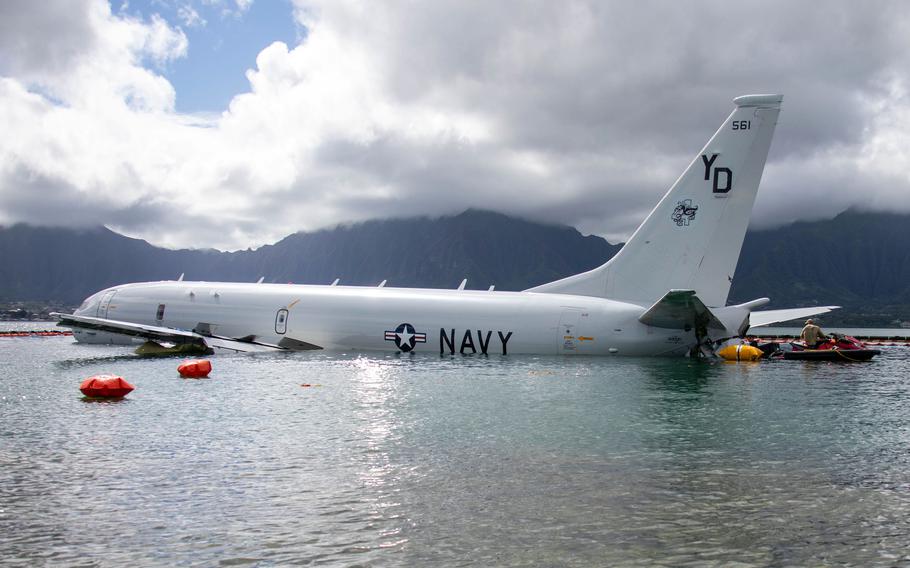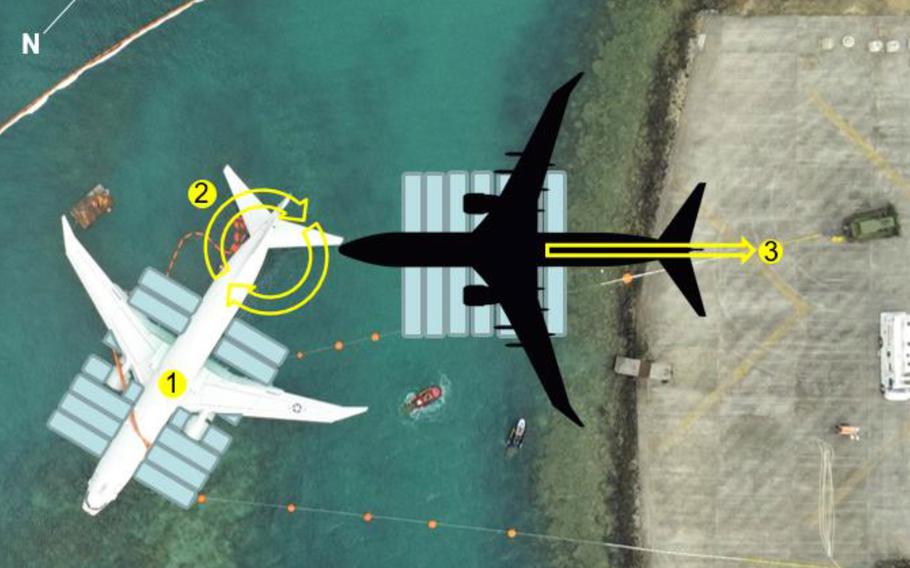
A U.S. Navy P-8A Poseidon rests in waters just off the runway at Marine Corps Air Station Kaneohe Bay. (Cody Purcell/U.S. Marine Corps)
FORT SHAFTER, Hawaii — The Navy plans to use “roller-bags” to recover a P-8A Poseidon resting in a shallow bay since it overran a runway at Marine Corps Base Hawaii on Nov. 20.
The salvage operation for the 60-ton reconnaissance plane is expected to begin Saturday morning, Rear Adm. Kevin Lenox, commander of Carrier Strike Group 3, said during a news conference from the base Friday.
“Our team has been working around the clock to develop a salvage plan for this aircraft that prioritizes the safety of our personnel and the safety of the critical ecosystems here in Kaneohe Bay,” Lenox said. “This morning we approved that plan.”
He declined to estimate how long the job would take, citing variable weather and tide conditions, as well as ensuring the safety of workers and protection of the environment.
The Poseidon was attempting to land at Marine Corps Air Station Kaneohe Bay, which lies on the windward coast of Oahu about 10 miles northeast of Honolulu, when it overshot the runway. None of the nine crew members were injured during the incident.
The plane’s front landing gear and a pair of wheels had been resting on a coral reef, but a strong tide Thursday lifted the plane slightly and shifted it 30 degrees, Lenox said.
The Poseidon belongs to the Patrol Squadron 4, based at Naval Air Station Whidbey Island, Wash.
Navy contractors will use a collection of roller-bags to first get the plane ashore and then roll it to a wash station, Lenox said.
“We have high confidence that we will be able to execute this thing with no further damage to the ecosystem,” he said.
The air-filled bags are slid under the plane perpendicular to the fuselage, from nose to tail. The buoyancy of the bags will float the plane off the coral.
Two huge winches will pull cables attached to the rear landing gears, while two other cables attached to the wings will be used to steer the hulk, Lenox said.
Once the plane reaches the shoreline at the end of the runway, it can be rolled on the bags while keeping the landing gear off the ground, he said.

A U.S. Navy graphic illustrates how a P-8A Poseidon plane will be salvaged with roller-bags from a bay adjoining Marine Corps Air Station Kaneohe Bay, where it overshot the runway on Nov. 20. (U.S. Navy)
The plan is to then determine whether the landing gear and wheels are intact enough to simply tow the plane to a wash station, where it will be cleansed of corrosive salt water.
If the gears look like they are damaged in a way that they cannot be used, the bags will be used to roll the plane to the wash station, Lenox said.
At that point, control of the plane will be returned to the Maritime Patrol and Reconnaissance Wing, whose personnel will begin cleanup and damage assessment, he said.
Only helicopters and Ospreys have been allowed to use the runway since the incident.
Fixed-wing aircraft are expected to resume using the runway after Hawaii’s Department of Land and Natural Resources assesses the condition of the coral reef.
“So obviously, we want operations to return as soon as possible,” Col. Jeremy Beaven, commander of Marine Corps Base Hawaii, said at the news conference.
“But I’m also sensitive to the need for DLNR to come and characterize [damage],” he said, adding that he expected there to be a 24-hour window for that state inspection.